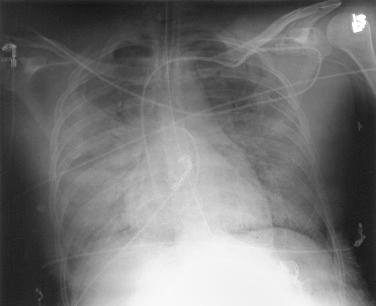Physical Address
304 North Cardinal St.
Dorchester Center, MA 02124
A 75-year-old man is taken to the operating room for urgent cholecystectomy. He becomes hypotensive intraoperatively despite adequate fluid resuscitation. At the end of the case, his arterial partial pressure of oxygen (Pa o 2 ) is 80 mm Hg with a fraction of inspired oxygen (Fi o 2 ) of 100%. He is taken to the intensive care unit, where a chest radiograph shows diffuse bilateral pulmonary infiltrates. He remains intubated for 5 days postoperatively, and is eventually discharged to a subacute rehabilitation facility after a prolonged hospital stay.
Postoperative respiratory failure has been defined as the need for prolonged mechanical ventilation for 48 hours or longer postoperatively or the need for unplanned reintubation after surgery. The most common causes of postoperative respiratory failure are acute respiratory distress syndrome (ARDS), atelectasis, pulmonary edema, and pneumonia. Appropriate recognition and treatment of the underlying cause is essential to the reversal of postoperative respiratory failure. Careful intraoperative management can play an important role in minimizing the risk of postoperative respiratory failure.
The clinical presentation of postoperative respiratory failure depends largely on the underlying cause. In addition to the pulmonary causes of respiratory failure discussed later, postoperative reintubation may also be indicated for upper airway obstruction or narcotic-induced respiratory depression. Nocturnal oxygen levels reach their nadir on postoperative day 3, suggesting that patients are at especially high risk for reintubation during this period.
Atelectasis is present in nearly all patients intraoperatively, but persists into the postoperative period in one-fifth of patients. It usually presents with hypoxemia and basilar consolidation on chest radiograph. Although postoperative fever has traditionally been attributed to atelectasis, multiple studies have failed to find any association between the two.
The diagnosis of postoperative pneumonia can be challenging. Pneumonia should be suspected in any postoperative patient with increased oxygen requirement. The combination of an infiltrate on chest radiography, fever, and leukocytosis is highly suggestive of a pneumonia, although these signs are nonspecific. Further signs of a developing pneumonia include purulent sputum or an increased requirement for airway suctioning, worsening cough or dyspnea, and pleuritic chest pain. Physical examination findings may again suggest the diagnosis, but are likewise nonspecific. Laboratory testing, including Gram stain and culture of respiratory secretions and immunostaining for conditions such as Legionella, may confirm the diagnosis and help guide antibiotic therapy.
Postoperative pulmonary edema can be classified into two broad categories, hydrostatic and permeability, depending on its presentation and predisposing risk factors. Hydrostatic pulmonary edema results from increased pressure across the pulmonary capillary walls, forcing fluid out of the capillaries and into the alveoli and interstitium. Hydrostatic pulmonary edema is often seen in ventricular failure or valvular disease, where it is termed cardiogenic edema. Even in the absence of heart disease, however, acute fluid overload can lead to hydrostatic pulmonary edema in the otherwise healthy postoperative patient. The excess fluid in the interstitium and alveolar air spaces impairs gas exchange and reduces the total volume of alveoli available for ventilation, which manifests as dyspnea and hypoxemia. Chest radiographs will classically reveal cephalization of the pulmonary vasculature, “bat wing” pulmonary opacities, peribronchial cuffing, and pleural effusions.
ARDS is a clinical condition in which inflammation leads to increased pulmonary capillary permeability. The resulting diffuse alveolar and interstitial edema decreases lung compliance and severely impairs oxygenation. The pathogenesis of ARDS is complex and multifactorial, and can be triggered by either intrapulmonary or extrapulmonary processes. ARDS presents with dyspnea, increased work of breathing, impaired oxygenation, and bilateral patchy infiltrates on chest radiograph ( Fig. 171.1 ). The clinical diagnostic criteria for ARDS were updated in a consensus statement in 2012 and are listed in Box 171.1 . Half of all hospital-acquired ARDS cases occur in surgical patients. The vast majority (nearly 80%) are associated with severe sepsis; other causes, including trauma, blood transfusion, aspiration, and pancreatitis, account for a small minority of cases.

Acute onset within 7 days of causative insult
Bilateral opacities on chest imaging not due to effusion, collapse, or nodules
Respiratory failure not fully explained by cardiac failure or fluid overload
Pa o 2 :Fi o 2 ≤300 with PEEP ≥5 cm H 2 O
Mild (Pa o 2 :Fi o 2 >200–300)
Moderate (Pa o 2 :Fi o 2 >100–200)
Severe (Pa o 2 :Fi o 2 ≤100)
Fi o 2, Fraction of inspired oxygen; Pa o 2 , arterial partial pressure of oxygen; PEEP, positive end-expiratory pressure.
Become a Clinical Tree membership for Full access and enjoy Unlimited articles
If you are a member. Log in here